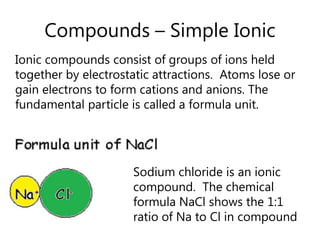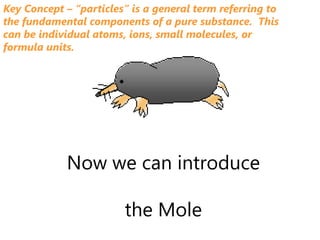2011 topic 01 lecture 1 - the mole and avogadro's constant
- 1. IB Chemistry Power PointsTopic 1Quantitative Chemistrywww.pedagogics.caLecture 1The Mole and Avogadro’s Constant
- 2. The Structure of MatterMatterPure SubstancesMixturesSolutionsElementsCompoundsCovalentIonicAtomsMoleculesFormula UnitsFundamental “particles” of pure substances
- 3. Elements - MetalsStructure of metallic elementsThe metal solids “particles” consist of individual metal ions held together by mutual attraction for each others valence electrons.
- 4. Elements – Noble GasesThe noble gases are the Group 8 (18) elements: He, Ne, Ar, Kr, Xe and Rn. They are extremely unreactive – considered to be inert. The fundamental particles of these elements are single atoms (monatomic).
- 5. Elements – Diatomic MoleculesSeven elements (H, N, O, F, Cl, Br, and I) are called the diatomic elements because, as pure elements, they form molecules containing two atoms. Different representations of Cl2The fundamental particles of these elements are molecules. Each molecule contains only one type of atom.
- 6. Elements – Other StructuresCarbon and silicon exist as giant covalent structures – networks of atoms held together by covalent bonds.Other non-metallic elements are found in molecular form.
- 7. Compounds – Molecular CovalentCovalent compounds consist of groups of two or more different types of atoms bonded together into particles called molecules.Water is molecular covalent compound consisting of H2O molecules.
- 8. Do not confuse the forces BETWEEN molecules with the bonds WITHIN moleculescovalent bonds hold hydrogen and oxygen atoms together to make water moleculesintermolecular forces exist between adjacent H2O molecules
- 9. Compounds – Simple IonicIonic compounds consist of groups of ions held together by electrostatic attractions. Atoms lose or gain electrons to form cations and anions. The fundamental particle is called a formula unit.Sodium chloride is an ionic compound. The chemical formula NaCl shows the 1:1 ratio of Na to Cl in compound
- 10. Compounds – Simple IonicTwo representations of NaCl
- 11. Key Concept – “particles” is a general term referring to the fundamental components of a pure substance. This can be individual atoms, ions, small molecules, or formula units.Now we can introducethe Mole
- 12. A mole is a unit of quantity.A mole is 6.02 x 1023 things.6.02 x 1023 is known as Avogadro’s constant (NA)÷ 6.02 x 1023Number of atoms, molecules or fundamental unitsNumber of moles (mol)× 6.02 x 1023
- 13. Why the Mole?Consider one molecule of waterHow many molecules in 2000 mL of water?6.7 x 1025 molecules
- 14. 6.7 x 1025 molecules is not a manageable number. Consider:We count eggs by the dozenWe measure long periods of time in centuries.We measure long distances in our universe using light years.
- 15. The MoleThere are many ways of measuring large quantities that utilize large units. The mole is one such unit.The mole is the SI unit for chemical quantity used to count the particles in a sample of pure substance.One mole = 6.02x1023 particles.“One mole of anything = 6.02x1023 units of that thing”
- 16. The MoleHow many molecules of water in 2000 mL?6.7 x 1025 moleculesOr 111 mol meaning 111 moles of water molecules. This is a much more manageable number.
- 17. How many atoms are in 0.065 mol of copper?3.9 x 10223.9 x 1022How many molecules are in 0.065 mol of CO2?3.9 x 1022How many formula units are in 0.065 mol of NaCl?How many moles is 9.03 x 1023 atoms of copper?1.51.5How many moles is 9.03 x 1023 molecules of CO2?1.5How many moles is 9.03 x 1023 formula units of NaCl?
- 18. How many oxygen atoms are in 1.4 x 10-7 mol of oxygen gas (O2)?(1.4 x 10-7) × NA= 8.428 x 1016 molecules of O22 atoms of oxygen per molecule sofinal answer = 1.7 x 1017 atoms of oxygen (2 SF)Given 1.76 x 1012 molecules of O2, how many moles of iron III oxide (Fe2O3) can be assembled?
- 19. Fe2O3is an example of aChemical Formulae
- 20. 4 atoms of oxygen1 atom of sulfur2 atoms of hydrogenWhat are chemical formulae?● short-hand notation● tells us the types of elements in a compound ● gives the number of atoms of each type of element in one molecule of the compoundH2SO4 sulphuric acid1 molecule of H2SO4
- 21. How many atoms in each?C6H12O6 glucoseMg(NO3)2 magnesium nitrateCu(SO4)2●5 H2O copper II sulfate hydrate
- 22. Relative Molecular (Formula) Mass (MR)RECALL: The average relative atomic mass (AR) for each element is noted on the Periodic Table. For example AR for copper is 63.55. Relative masses are based on 1/12th the mass of a 12C atom.The relative molecular mass is the total mass of the atoms in one molecule or formula unit of a particular compound relative to carbon-12.For example H2SO4:Hydrogen 2 atoms × 1.01 = 2.02Sulfur 1 atom × 32.07 = 32.07Oxygen 4 atoms × 16.00 = 64.00 MR 98.09
- 23. Molar MassAre you sitting comfortably?
- 24. Mass and the Mole: Why 6.02×1023?1 mole = 6.02×1023 was chosen because this was then number of carbon-12 atoms that has a mass of 12 grams.Pure carbon (a mix of isotopes) has a mass of 12.01 g per mole.We call this value MOLAR MASSConsider1 atom of sulfur AR = 32.07 = 5.326×10-23 gramsConsider1 mole of sulfur = 6.02×1023 atoms = 32.07 grams
- 25. 6.02×1023 is a REALLY BIG numberConsider 6.02×1023sheets of paper stacked. How many round trips to the Moon would this stack of paper be equivalent to? 8×1010 (eighty billion ) roundtrips. Create, pick, find a mole analogy of your own. Show the math.
- 26. MOLARMASSLanguage issuegram atomic massgram molecular massgram formula massAluminum AR = 26.98 gram atomic mass = 26.98 g mol-1Carbon dioxide (CO2) MR = 44.00 gram molecular mass = 44.00 g mol-1Sodium chloride (NaCl) MR= 58.44 gram formula mass = 58.44 g mol-1
- 27. We weigh chemical quantities in grams. The molar mass value for a substance allows us to determine the number of moles from a measured mass.Consider 5.68 g of MgCl2Molar mass of MgCl2 = 95.21 g mol-1
- 28. ÷ 6.02 x 1023× molar massNumber of atoms, molecules or fundamental unitsMOLESMASS× 6.02 x 1023÷ molar mass
- 29. 1. How many moles are in 45.0 g of water?2.50 mol77.0 g2. What is the mass of 1.75 mol of CO2?9 moles3. How many moles of oxygen atoms are in 300 g of CaCO3?95.3 g4. What is the mass of 9.03 x 1023 atoms of copper?0.589 mol5. 106 g of glucose (C6H12O6) is how many moles?56.5 g6. What is the mass of the oxygen atoms in 106 g of glucose?




























